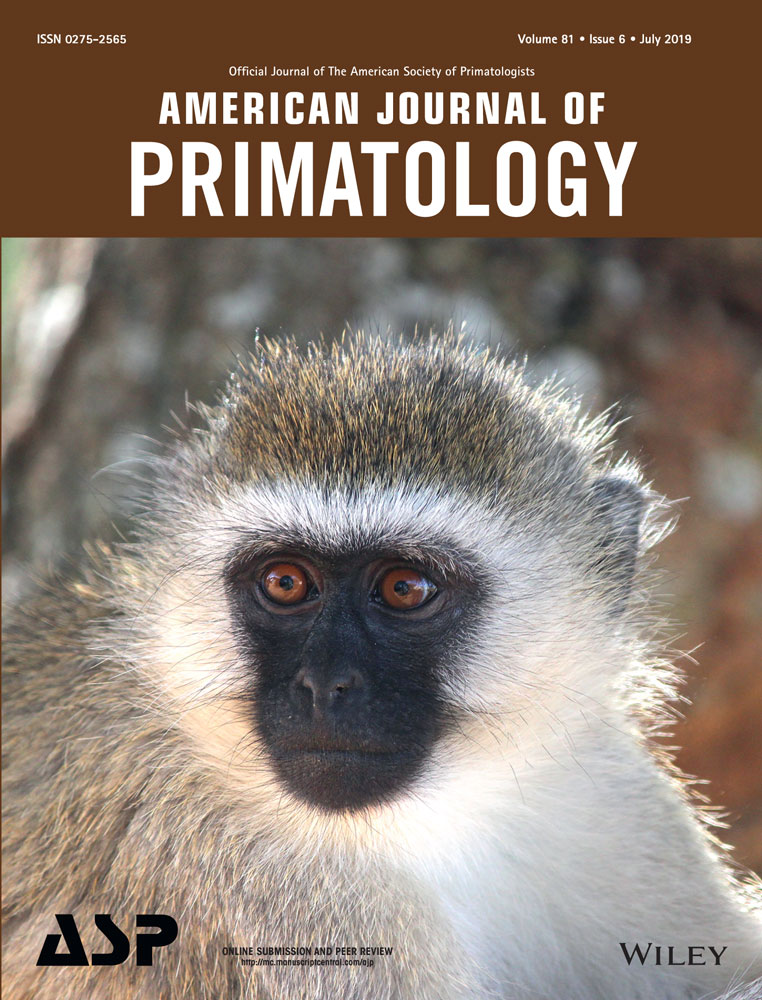Capture of Alouatta guariba clamitans for the surveillance of sylvatic yellow fever and zoonotic malaria: Which is the best strategy in the tropical Atlantic Forest?
Abstract
Howler monkey capture is an arduous and expensive task requiring trained and specialized professionals. We compared strategies and methods to most efficiently capture Alouatta guariba clamitans in remnants of the Atlantic Forest in Rio de Janeiro and its bordering states of Minas Gerais and São Paulo. We tested whether or not the success of expeditions in the forest with anesthetic darts, nets, and baited traps differed with and without the support of an information network, a contact chain built with key institutions and inhabitants to continuously monitor howler monkey presence. The influence of forest conditions (vegetation type and fragment size) upon darting success was also evaluated. We captured 24 free-living A. guariba clamitans. No howler monkey was caught with traps, probably due to the predominantly folivore feeding to high local plant diversity providing a great variety of food options. Captures based on an information network were significantly more efficient in terms of numbers of caught monkeys than without it. Captures with darts were considerably more efficient when performed in semideciduous forests and small forest fragments as opposed to ombrophilous forests or large woods. Although we walked great distances within the forest searching for howler monkeys, all but one animal were captured at the forest fringes. Hindrances to search and the darting method in the Atlantic Forest, for example, the steep terrain, high tree canopies, hunt pressure, and low A. guariba clamitans population density, were mitigated with the use of the information network in this monkey capture. Moreover, the information network enhanced the surveillance of zoonotic diseases, which howler monkeys and other nonhuman primates are reservoirs in Brazil, such as malaria and yellow fever.
HIGHLIGHTS
-
The construction of an information network with key institution and resident contacts optimize the efforts of howler monkey (Alouatta guariba clamitans) capture.
-
The network can be easily maintained through mobile message exchange apps.
-
Focusing howlers searches in small and semideciduous forest fragments are the best strategies to enhance capture efficiency when using anesthetic darts in the Atlantic Forest.
1 INTRODUCTION
The capture of nonhuman primates (NHPs) has been performed for several scientific purposes, such as genetic, ecological, or sanitary aims. Traps are widely adopted for small and frugivorous neotropical primates capture (Watsa et al., 2015). However, the capture of wild howler monkeys is an arduous and expensive task requiring trained and specialized professionals. Howler monkey groups prefer the high forest canopies and feed predominantly on leaves, complicating access and reducing the efficacy of fruit-baited traps (Brasil, 2017a). Few authors have reported success in trapping howler monkeys such as Aguiar et al. (2007), capturing 70 Alouatta caraya with traps installed in the tree canopy. Therefore, despite the complexity and high risk of animal injury or even death, the most common technique for Alouatta capture is the anesthetic dart gun. With this method, 130 Alouatta palliata were captured and marked in La Pacifica, Costa Rica, between 1973 and 1975 (Scott, Júnior, & Malmgren, 1976), and 688 from 1973 to 1991 (Teaford & Glander, 1991), in a dry and deciduous forest environment within small woods surrounded by pastures (Clarke, Zucker, & Scott, 1986; Scott et al., 1976). There also have been reports of success with the same method in capturing howlers for ecological or epidemiological studies in Argentina, Costa Rica, Venezuela, and Panama, where 20–100 specimens were captured in a single month (Martínez, Kowalewski, Salomón, & Schijman, 2016; Milton, Lozier, & Lacey, 2009; Rumiz, 1990; Scott et al., 1976). In Brazil, the methodology was widely adopted during the 2008–2009 YFV outbreak in Rio Grande do Sul, where more than 270 animals were captured (Brasil, 2017a). Although the dart methodology is well established, little has been discussed on the importance of involving institutions and local inhabitants before and after the field expeditions. Approaches based on ethnoprimatology can provide clues and methods to take advantage of local resident knowledge and interaction with NHPs during the fieldwork (Jones-Engel, Engel, & Fuentes, 2011), contributing in the construction of an information network as a means of optimizing capture efforts.
NHPs can harbor several parasites infectious to man. In Brazil, since 1966, human autochthonous malaria in areas under the influence of the Atlantic forest has been suspected to have simian origin caused by Plasmodium simium, the original and primary host being howler monkeys, genus Alouatta (Deane, 1992). The confirmation of this zoonotic cycle has only been achieved very recently by molecular examination of local Alouatta (Brasil et al., 2017; Buery et al., 2017).
Sylvatic yellow fever is a viral zoonotic disease accidentally transmitted from viremic NHPs to man by arboreal primatophilic mosquitoes. Recently, the virus (YFV) has re-emerged in the Atlantic Forest, Southeast Region, causing numerous human cases and deaths besides having a huge impact on NHP biodiversity resulting from thousands of epizootic events (Bonaldo et al., 2017; Brasil, 2017b). Species of genus Alouatta are among the most susceptible to the YFV considering the number of dead animals or even population extinctions during epizooties (Araújo et al., 2011; Moreno et al., 2013; Moreno et al., 2015). The new affected area corresponds to the territory of three Alouatta taxa: A. caraya, A. guariba guariba, and mostly, A. guariba clamitans, the brown howler monkey, which has been the most affected since the beginning of this YFV expansion (Almeida et al., 2012) and the only Alouattinae found in Rio de Janeiro (RJ). Yellow fever surveillance includes active investigation, which consists of capturing free-living NHPs followed by the collection of blood samples for early detection of the virus and/or specific antibodies. This action aims to obtain evidence of viral circulation for the risk prediction of YFV transmission to human populations (Brasil, 2017a).
In 2015, we initiated a program for NHP capture focusing on howlers in response to the expansion of the YFV toward RJ and the increase in the number of autochthonous malaria cases in the state. Herein, we compare strategies and methods to most efficiently capture A. guariba clamitans in remnants of the RJ Atlantic Forest and its borders. Particularly, we wanted to test whether or not the capture success with darts or nets differs with or without the support of an information network composed of several kinds of agents, mostly from key institutions and residents in target areas. In addition, we wanted to find out the possible variation of dart capture efficiency in different forest types and fragment sizes. Finally, baited trap application on tree platforms for howler capture was evaluated in two different forest environments.
2 DESCRIPTION
2.1 Ethical statement
Our methods and protocols were previously approved by the Institutional Ethics Committee for Animal Experimentation (Protocol CEUA/IOC-029/2016, license L-037/2016) and by Brazilian Ministry of the Environment (SISBIO 41837-3 and 54707-4) and Rio de Janeiro's Environment agency (INEA 012/2016 and 019/2018). The research adhered to the American Society of Primatologists Principles for the Ethical Treatment of Nonhuman Primates.
2.2 Capture efforts
The following two main strategies were tested to capture A. guariba clamitans between 2015 and 2017: (a) Expeditions with active searches employing the use of anesthetic dart guns in the forest without any previous alert from an information network, and, alternatively, (b) the construction of an information network with key institution and resident contacts incorporating the use of anesthetic dart guns, canopy baited traps, or nets upon alerts raised in this information network.
Besides, the efficiency of capture with anesthetic darts was evaluated under influence of two different forest environments (semideciduous seasonal forests vs. ombrophilous forest) and two fragment size categories (<100 ha vs. >100 ha).
2.2.1 Anesthetic dart capture during the expeditions without any previous alert from the information network
Seven long-term capture expeditions were orchestrated with an average duration of 13.5 days each. Six expeditions occurred in the regions of dense ombrophilous forest, covering 13 municipalities in 82 days, 63 of which were entirely devoted to the active search of howlers in the forest, the remaining days being spent journeying between forest fragments and inspection areas. One expedition was on the western slope, in the semideciduous seasonal forest, covering four municipalities in 13 days, 9 of which were totally devoted to howler search (Table 1). The howler search fieldwork was conducted by three to six trained investigators with a local guide entering the forest as quietly as possible. When howlers were encountered, anesthetic darts were targeted at the lower limbs of the largest animals in the group. The collection, biosafety, and anesthesia protocols complied with the rules and regulations of the Brazilian Ministry of Health (Brasil, 2017a). The darts contained a combination of ketamine (15 mg/Kg), midazolam (1 mg/Kg), and levomepromazine (1 mg/Kg), and alternatively, an association of tiletamine and zolazepam (4–5 mg/Kg). After anesthesia, a large nylon net was opened to catch the falling anesthetized animals. In some cases, the fall was induced by shaking the tree branch, supporting the animal with a rope. After sample collections and complete recovery of anesthetic effects, animals were released in the same place during the daytime. Only one monkey was injured by fracturing one femur during the fall while anesthetized, which was afterward treated and kept in a primate-breeding center (Centro de Primatologia do Rio de Janeiro—CPRJ).
| Strategies | Total days spent | Total captured howlers | Capture methodology | Vegetation type | Fragment size | ||
|---|---|---|---|---|---|---|---|
| SDFa | ODFb | Up to 100 ha | > 100 ha | ||||
| Expeditions without the information network alert | 95 | 9 | 9 (dart) | 4 (9) | 5 (63) | 8 (29) | 1 (43) |
| Expeditions with the Information network alert | 23 | 15 | 3 (dart), 12 (net) | 9 (11) | 6 (11) | 10 (12) | 5 (10) |
| Platform baited trap | 336 | 0 | 0 (trap) | 0 (175) | 0 (161) | 0 (161) | 0 (175) |
| Total | 454 | 24 | _ | 13 (195) | 11 (235) | 18 (202) | 6 (228) |
- Note: The number of working days searching for monkeys in each kind of forest and forest fragment size in parenthesis.
- a Semideciduous seasonal forest.
- b Ombrophilous dense forest.
2.2.2 Information network-based captures—development and operation
The network was developed by establishing long-distance and personal contacts with three main types of agents/actions: (a) Residents, health agents, environmental guards, conservation unit managers, and local guides living in the target municipalities. To raise awareness about the importance of primate surveillance, we personally interviewed these agents in the field during the expeditions or short-term trips (1–3 days) before capture expeditions. We also organized lectures in local schools, community centers, and health departments aiming to amplify the network. (b) Patients affected by autochthonous malaria who usually have a secondary residence in the target area, introducing us to local residents, which were added to the groups amplifying the network. (c) We established collaborations with primate research groups working in several areas in the state of RJ.
Groups composed of all agents were created on WhatsApp mobile messenger application (WhatsApp Inc., Delaware Corporation, CA) for each location. Besides contact through WhatsApp, we made periodic phone calls and sent messages to key agents. By receiving information in real time, the howler monkey presence in specific sites, situation, and time was continuously monitored in each area even in our absence. Short-term capture trips to target areas were elaborated (Table 1) whenever our network agents efficiently informed the presence of healthy or sick howler monkeys in their locality.
2.2.3 Installation of canopy traps in platforms
Two platforms were established with the main purpose of baiting and trapping whole groups of A. guariba clamitans, the traps being designed according to Aguiar et al. (2007). The selected trees for installation of both platforms were defined according to suggestions from the members of the information network (arrows in Figure 1). The trap front and back doors were kept open for 2 months to allow free circulation, enhanced by the continuously replenished baits. Afterward, the back door was sealed but the entrance remained open for the animals to access the bait, and about 8 kg of fresh fruits and vegetables was renewed every 3 days. The regular bait was banana, mango, guava, corn, and coconut. Eventually, other options such as peas and string beans were tested in an attempt to provide food closer to the predominantly folivorous Alouatta diet. Platform 1 was set at a 20-meter height in the Municipal Natural Park of Atalaia, a large forest fragment of approximately 1,183 hectares located at an altitude of 120 meter on the plains of the Macaé municipality, on the east side of Serra do Mar, 166 kilometers from the city of Rio de Janeiro, where our laboratory is located. The predominant vegetation is the dense ombrophilous lowland type (IBGE, 2012). Platform 2 was placed at a 12-meter height on a farm located on the western slope of Serra do Mar in the municipality of Sumidouro at an altitude of 1,080 meter and 147 kilometers from Rio de Janeiro. This forest consists of about 60 hectares of connected patches of predominantly semideciduous seasonal vegetation type in which the tree canopies were lower than those of the platform 1 area. According to reports of our information network, the high branches of few trees were the only passage for a group of howlers to cross an unpaved road that separates two forest fragments. We pruned these branches and linked the platform to the trees located on the opposite side of the road with ropes intending to force the animals to pass close to the trap entrance. Cameras with a motion infrared sensor were installed for 24-hr surveillance of the visiting animals in both platforms. Platform 1 was monitored for 23 weeks, from September 2015 to February 2016, the end of the dry and beginning of the wet seasons, respectively, while platform 2 was monitored for 25 weeks, between July and December 2016, essentially the dry season.
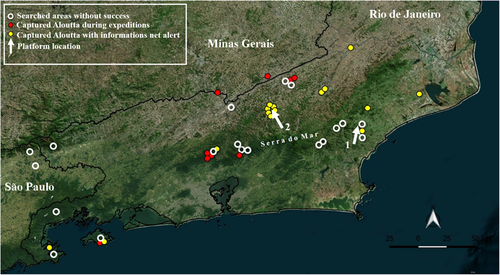
Satellite image of Rio de Janeiro showing sampled areas, relief, and vegetation. Red circles represent Alouatta captured with active searching during expeditions. Yellow circles represent Alouatta captured after our network alert. White transparent circles represent areas where we performed active search during expeditions but failed to capture Alouatta. White arrows indicate the locations of platforms 1 and 2
2.3 Study area
The fieldwork was carried out between May 2015 and June 2017 in several locations in the Atlantic Forest, in RJ as well as frontier sites in the Southeastern states of Minas Gerais (MG) and São Paulo (SP; Figure 1). Due to deforestation, forests with ecological conditions to support larger NHPs have essentially been reduced to fragments on hilltops scattered in lowlands or mountain valleys and escarpments of “Serra do Mar” (Ribeiro, Metzger, Martensen, Ponzoni, & Hirota, 2009), which makes RJ different from other regions where howler monkeys have been captured. Serra do Mar is a mountain chain forming a large and long ecological corridor (CEPF, 2005). Its eastern slope, facing the ocean, has the largest continuous forest in the state and sustains primary or secondary dense ombrophilous forest predominant vegetation (IBGE, 2012). On the western slope, toward MG, the vegetation is replaced by semideciduous seasonal forest (IBGE, 2012) exhibiting high degrees of fragmentation (Figure 1). The choice of capture areas took into account scientific papers reporting howler occurrence, recent human malaria cases, and the existence of important river basins and denser forests, connecting states and wooded fragments, which may serve as a corridor for NHPs and YFV dispersal.
2.4 Statistical analyses
The capture efficiency (CE) and its standard deviation (SD) were calculated by dividing the number of captured howlers by the capture effort (number of days spent in the capture) considering the sampled forest fragment. First, the CE was compared between the strategies with or without the use of an information network through a two-sided Kruskall-Wallis test, since this parameter was non-normally distributed (Shapiro-Wilk, p < .05). Subsequently, the CE of searches with anesthetic darts was contrasted between forest types (semideciduous seasonal and dense ombrophilous) and forest fragment sizes (smaller or larger than 100 ha) with the same statistical test. p-values were adjusted for multiple comparisons according to the Bonferroni criteria and were considered statistically significant when these values were equal to or less than .05. The response variables were not correlated according to variation inflation factors (VIFs; i.e., VIF <5). All statistical analyses were performed with R version 3.0.2.
3 EXAMPLES
Between 2015 and 2017, 24 wild A. guariba clamitans were captured and examined, nine during the active search in the forest without any previous alert from an information network, and 15 based on the information network (Table 1).
3.1 Effects of the information network
The captures based on the information network alert were more efficient (Kruskal-Wallis, p < .05; Figure 2). On average, 0.92 howlers (SD =0.4) were captured per day during efforts based on alerts from the network versus 0.19 (SD =0.4) without the alert of the network information.
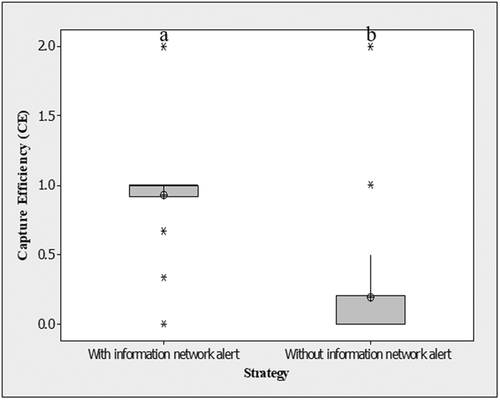
Boxplot of the capture efficiency (CE), of the two strategies tested: With and without the support of the Information Network. Different letters mean statistical difference (Kruskall-Wallis; p < .05)
Of the 15 howlers captured based on the information network, six (40%) were reported by conservation unit managers, six (40%) by residents, two (13.3%) by other researchers, and one (6.6%) by the municipal health department manager. Six were captured in dense ombrophilous forests and nine in semideciduous. Concerning capture methods, 12 were captured with nets as they were either sick (n = 8) or easily attracted by fruits regularly offered by neighboring farmers (n = 4) and three with anesthetic darts in two field expeditions of 2 days each.
Importantly, during the YFV outbreak in Rio de Janeiro (2017–2018), the information network enabled us to find and collect material from 14 other sick, agonizing, or dead A. guariba clamitans besides two marmosets (genus Callithrix), but they were not included in the analysis to prevent bias in our statistical comparison of capture method efficiency.
3.2 Effects of forest characteristics in dart capture efficiency
In total, 12 howlers were captured using darts, being seven in semidecidual and five in dense ombrophilous forest. The CE, when using anesthetic darts, was significantly higher in semideciduous seasonal forest (0.56 howler/day on average, SD: 0.67) compared to the ombrophilous forest (0.051 howler/day on average, SD: 0.1; Kruskall-Wallis, p < .05; Figure 3a).
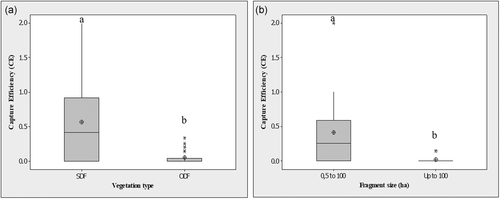
(a) Boxplot of the CE in two types of vegetation: Semideciduous seasonal and dense ombrophilous. (b) Boxplot of the CE in two categories of fragments sizes: Small (up to 100 ha) and large (more than 100 ha). Different letters mean statistical difference (Kruskall-Wallis; p < .05). CE, capture efficiency
Regarding fragment size, 11 howlers were captured in those considered small (up to 100 ha) and one in those termed large (>100 ha). The forest fragment size also influenced the capture success with darts. The CE (0.4 howler/day on average, SD: 0.5) in the 29 days of work in seven small forest fragments (0.5–100 ha) was significantly higher than those captured in 43 days of work in 17 large fragments (>100 ha, corresponding to 0.01 ± 0.03 howlers/day; Kruskall-Wallis, p < .05; Figure 3b).
Although we walked great distances and spent a lot of time in search of howler monkeys (up to 8 search hours per day), 11 of the 12 dart-captured animals were obtained less than 1 km from the forest fringe. Only one animal was captured deep inside the forest.
3.3 Trapping evaluation
No howler monkey entered the traps or consumed the scattered fruits in proximity even after more than 23 weeks of the food supply in the two study areas. The target howler monkey groups were frequently detected using the highest arboreal branches above platform 1 and crossing the ropes installed close to platform 2 (Figure 4). After 4 weeks of baiting, a group of capuchin monkeys (Sapajus nigritus) began to access trap 1 (Figure 5a), of which we captured and examined two. The camera trap caught several rodents, marsupials, and birds consuming the bait and made the first record of a kinkajou Potus flavus in the Atalaia Park (Figure 5b).
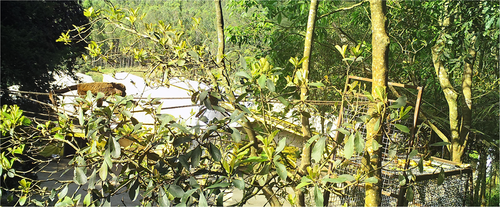
A. guariba clamitans crossing the road through the rope, very close to the baited trap in platform 2. It never entered or examined the platform or the baits. Panoramic image was assembled using the software Microsoft Image Composite Editor 2.0 (ICE)
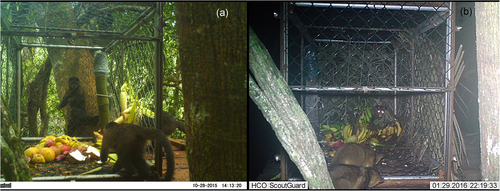
Records of animals consuming the bait inside the trap installed at platform 1. (a) Group of Sapajus nigritus. (b) First record of kinkajou (Potus flavus) in the Atalaia Park. It is possible to distinguish two kinkajou and an opossum
After our survey, the traps were removed and the platforms were maintained for utility by other researchers, mostly for bird watching.
4 COMPARISON AND CRITIQUE
This was the first time that different strategies for A. guariba clamitans capture were evaluated in different forest types and distinct fragment sizes of the Atlantic Forest. We showed that through an information network, it was possible to collect and examine more animals in less time. The number of animals we examined based on alerts from the information network was 66.6% higher than that obtained in active search without it. Both the capture time and the expended financial resources have significantly dropped with the network. In addition, during the YFV outbreak, the information network helped in reducing the time between finding monkeys and the laboratory diagnosis, contributed to rapid notification in the state of Rio de Janeiro, minimizing the damage to the human population bordering the epizootics.
Although the elevated costs and high injury risks, the most popular technique for howler capture is the anesthetic dart, with which populations of Alouatta have been monitored for decades in different regions in Latin America (Martínez et al., 2016; Rumiz, 1990; Scott et al., 1976). These studies were conducted in highly fragmented or isolated patches of woods, in essentially flat terrains, generally covered with secondary semidecidual forests (Froehlich, Thorington, & Otis, 1981; Martínez et al., 2016; Milton et al., 2009; Rumiz, 1990; Scott et al., 1976).
However, we had lower capture success in Rio de Janeiro, especially when working in the dense ombrophilous forest type and in larger fragments (>100 ha). The dense ombrophilous forest in Rio de Janeiro has a canopy over 20 meters in height, composed of several intermediate tree limbs that reduce visibility and hamper efficient dart gun procedure. In addition, the steep terrain may provide lower vegetation sustenance, consequently, decreasing food availability, which results in lower primate densities (Assumpção, 1983; Pinto, Claudia, Costa, & Fonseca, 1993). In general, large forest fragments also present reduced monkey densities by favoring dispersal and movement. Also, this kind of forest may harbor large predators and competitors (González-Solís, Guix, Mateos, & Llorens, 2001). Besides, the hunting pressure reported by residents, park managers, and environmental guards during the interviews, may have contributed to the scared behavior of the howlers in Rio de Janeiro (Araújo, Souza, & Ruiz-Miranda, 2008; González-Solís et al., 2001; Pinto et al., 1993). Together, these factors may explain the capture difficulty, reinforcing the importance of other methodologies in this type of environment.
The great advantage of darting for yellow fever surveillance in NHPs is the mobility since it allows sampling different areas of interest at any time (Brasil, 2017a). However, our results indicated that this application should be prioritized either in small and flat fragments of semideciduous secondary forest or on islands due to the confined area limiting animal dispersal, facilitating animal encounter. Due to the difficulties reported, we recommend monitoring based on the construction of an information network before captures, especially for the mountainous region (Serra do Mar) in the Brazilian southeastern states. As an initial approach, active search and howler capture with dart guns would be recommended at the fragment fringe as well as at sites with constant sightings of Alouatta previously reported by local inhabitants and the information network. Finally, net capture seems to be the simplest and cheapest technique in the case of diseased or baited animals reported by the information network.
Intriguingly, all but one A. guariba clamitans were caught less than 1 km from the forest fringe in Rio de Janeiro, which may suggest that long hikes in rough terrain deeper into the forest were inefficient. Probably the team movement within the forest might have startled the howler monkeys, inducing them to disperse or hide, especially under the hunter pressure reported by residents. The same was observed by Jones and Bush (1988) when capturing Cercopithecus. The only animal we captured deep inside the forest was encountered on a flat and well-marked trail in Ilha Grande State Park, Angra dos Reis, a protected and isolated island, which facilitated howler encounter (Oliveira, 2011).
The use of baited traps is inefficient for capturing howlers because they have a predominantly folivore feeding habits and can forage on dozens of tree species as well as consume sprouts, flowers, and fruits depending upon availability (Aguiar et al., 2007; Chiarello, 1994). Despite this, one study reports the success in capturing 70 Alouatta caraya in the Paraná river basin, Southern Brazil (Aguiar et al., 2007). In contrast, we failed to trap A. guariba clamitans in Rio de Janeiro. We attribute this failure to the following factors: (a) Higher plant and animal richness and diversity in RJ, providing more options to the howler monkeys and discouraging bait attraction. Moreover, baits were consumed more rapidly by birds and other mammals, differently from that reported in the isolated areas in Paraná (Aguiar et al., 2007). (b) Interspecific behavioral difference: The species trapped by Aguiar et al. (2007) was Alouatta caraya, commonly found in very disturbed secondary forests, presenting a more diverse diet than brown howlers when in sympatry (Agostini, Holzmann, & di Bitetti, 2010). The predominantly folivore feeding habits together with differences in population densities and group size could essentially explain the reduced attraction of A. guariba clamitans to the bait offered in our traps. Perhaps, a long-term program of baiting in special circumstances (very small forest fragments, low availability of preferred food, long dry season, and absence of competitors) may increase the chance of A. guariba clamitans allurement to traps but demands great physical effort and human resources.
Our results demonstrate that the most efficient strategy to enhance howler monkey capture in the Atlantic Forest is the use of an information network. Its creation requires an initial investment of time and we emphasize the importance of involving health and environmental agencies with the inclusion of reserve managers, environmental guards, and hiker associations in the information network as these agents deal daily with natural environments and are usually the first to come across sick or dead animals. Currently, technology is a helpful tool. Message exchange apps such as WhatsApp or Telegram facilitate communication, providing comprehensive and cost-effective interaction among the agents involved. Hence, it is an efficient and inexpensive method of monitoring the primate population, according to the researchers to take advantage of the best methods to capture howlers according to the species, and ecological aspects. Its application can be adopted for the collection of samples destined for ecological, evolutionary, and especially, epidemiological studies, with the objective of understanding zoonotic diseases and predicting epidemics threatening man.
ACKNOWLEDGMENTS
The authors thank Carlos Alberto C. da Silva, Alexandre B. de Souza, Vicente Klonowski, Romenique L. Araújo, Luiz R. Nogueira, Fernando Barreto, Ana L. Quijada, Luiz P. P. Silva, Gelson Medeiros, Adilson B. Ramos, Marcilene B. Ramos, Carlos A. A. Júnior, Paulo G. Barbosa, Sérgio F. Fragoso, Adilson R. Silva, Silvia B. Moreira, Alcides Picinatti, Leonardo Nascimento, Cecília Cronemberger, Marcelo Rheingantz, Anielle P. Costa, João Marins, Lucas Perillo and Paulo D'Andréa for forming our network and for their valuable field support during expeditions. The authors thank Mariana R. David for her valuable support concerning data analyses. They also thank Fundação de Amparo à Pesquisa do estado do Rio de Janeiro (FAPERJ) for financial support. Mitchell Raymond Lishon edited the manuscript and its revisions for English.
CONFLICT OF INTERESTS
The authors declare that there are no conflict of interests.



